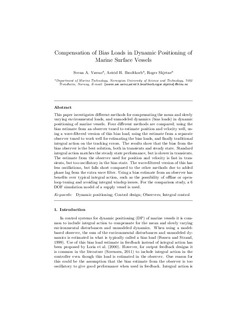| dc.contributor.author | Værnø, Svenn Are Tutturen | |
| dc.contributor.author | Brodtkorb, Astrid H. | |
| dc.contributor.author | Skjetne, Roger | |
| dc.date.accessioned | 2020-01-21T13:09:27Z | |
| dc.date.available | 2020-01-21T13:09:27Z | |
| dc.date.created | 2019-07-02T13:39:00Z | |
| dc.date.issued | 2019 | |
| dc.identifier.citation | Ocean Engineering. 2019, 484-492. | nb_NO |
| dc.identifier.issn | 0029-8018 | |
| dc.identifier.uri | http://hdl.handle.net/11250/2637255 | |
| dc.description.abstract | This paper investigates different methods for compensating the mean and slowly varying environmental loads, and unmodeled dynamics (bias loads) in dynamic positioning of marine vessels. Four different methods are compared; using the bias estimate from an observer tuned to estimate position and velocity well, using a wave-filtered version of this bias load, using the estimate from a separate observer tuned to work well for estimating the bias loads, and finally traditional integral action on the tracking errors. The results show that the bias from the bias observer is the best solution, both in transients and steady state. Standard integral action matches the steady state performance, but is slower in transients. The estimate from the observer used for position and velocity is fast in transients, but too oscillatory in the bias state. The wave-filtered version of this has less oscillations, but falls short compared to the other methods due to added phase lag from the extra wave filter. Using a bias estimate from an observer has benefits over typical integral action, such as the possibility of offline or open-loop tuning and avoiding integral windup issues. For the comparison study, a 6 DOF simulation model of a supply vessel is used. | nb_NO |
| dc.language.iso | eng | nb_NO |
| dc.publisher | Elsevier | nb_NO |
| dc.rights | Attribution-NonCommercial-NoDerivatives 4.0 Internasjonal | * |
| dc.rights.uri | http://creativecommons.org/licenses/by-nc-nd/4.0/deed.no | * |
| dc.title | Compensation of bias loads in dynamic positioning of marine surface vessels | nb_NO |
| dc.type | Journal article | nb_NO |
| dc.type | Peer reviewed | nb_NO |
| dc.description.version | acceptedVersion | nb_NO |
| dc.source.pagenumber | 484-492 | nb_NO |
| dc.source.journal | Ocean Engineering | nb_NO |
| dc.identifier.doi | 10.1016/j.oceaneng.2019.03.010 | |
| dc.identifier.cristin | 1709408 | |
| dc.description.localcode | © 2019. This is the authors’ accepted and refereed manuscript to the article. Locked until 18.3.2021 due to copyright restrictions. This manuscript version is made available under the CC-BY-NC-ND 4.0 license http://creativecommons.org/licenses/by-nc-nd/4.0/ | nb_NO |
| cristin.unitcode | 194,64,20,0 | |
| cristin.unitname | Institutt for marin teknikk | |
| cristin.ispublished | true | |
| cristin.fulltext | postprint | |
| cristin.qualitycode | 1 | |

